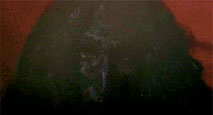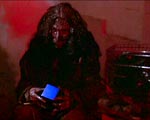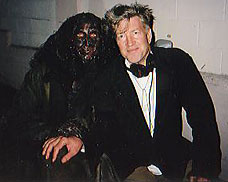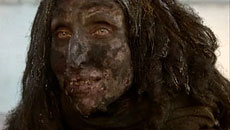Bum![]() BonnieAarons
BonnieAarons
|
Sex |
|
? |
|
|
Origin |
Dumpster |
||
|
Address |
Behind the Wall at Winkie's |
||
|
Occupation |
Boo people |
||
|
Fashion style |
Dirty |
||
|
Relationship |
Diane |
||
|
Doppelganger |
Louise Bonner?, Camilla? |
Possible Interpretations - (BriteLite)
(1) the ultimate power figure behind everything (maybe a funny allusion to director of this film?)
(2) representation of Diane's fears
(3) more universal representation of, what Freud defines as "ID" of Diane Selwyn
(4) The "angel of death" as he happens to appear in the film where somebody is just about to die/died
Perhaps he is a behind-the-scenes manipulator. Just as Mr Roque manipulates events in the material world, the bum hold far greater power - control over a person's soul. In Diane's delusional state, a homeless bum - perhaps the lowest in the social structure of society - becomes all-powerful, the possessor of Diane's soul, or fate. Diane has seen through those walls, witnessed him face to face, and believing that "he is the one that's doing it." believes herself to be powerless to stop him. Just like Dan in the dream, Diane's only response is the inability to go on. Fate has decided that she cannot live.
The homeless man is Diane's acknowledgement of her own mental problems, her own schizophrenia, if you will. A very important distinction is that the man exists both in Diane's dream and when she wakes up as the same character. I think that in both cases it's an abstraction, maybe the Unknown, but I think that Diane is admitting to herself that she has a problem and it is dangerous and life-threatening, not only to Camilla but also to her. We see that as Dan confronts the homeless man and dies - just as Diane does at the end of the film. - (Andy Ross)
 I believe that
the dark figure behind the wall is the intrusion of reality in some fashion. Maybe he merely represents -the crime- in the objective sense. That's why he's out back at Winkies and nowhere else. That is where the deal was consummated; where the money changed hands.
The man is a prefiguring or the judgment of
Diane's dirty deed, which is her death.
I believe that
the dark figure behind the wall is the intrusion of reality in some fashion. Maybe he merely represents -the crime- in the objective sense. That's why he's out back at Winkies and nowhere else. That is where the deal was consummated; where the money changed hands.
The man is a prefiguring or the judgment of
Diane's dirty deed, which is her death.
Or maybe he's the worst part of Diane's psyche. He could either be her irrational, self-destructive tendencies, or some sort of psychological unbalance, which would explain why he murders Dan (representing the one witness to her lover's murder), and then heralds Diane's suicide.
Then again, he could merely be a gatekeeper between the dream world and the real world. Mishappen, demonic, and poverty-stricken characters are often symbolically representative of the force that separates one world from another (Legba and Baron Samedi in voodoo, the man at the crossroads as the symbol of the Devil). Him killing Dan would then be rationalized as destroying an unnecessary intrusion of the real world into Diane's fantasy, and him opening the blue box would make particular sense. The box would represent reality, and the bum is exposing Diane to the absolute reality of her crime. - (Death Panda)
A striking indication of this point is the prominent use of the Winkie's "bum" as the instantiation of the Dark Force (both inside Diane and also of Hollywood itself). A homeless person living behind the dumpster on Sunset Blvd. is the polar opposite of "Hollywood success" a la Adam, Castigliane brothers and the whole glamorous crowd at the pool party. Hollywood is about dreams, money, attention, whereas the homeless is about poverty, disaster, and lack of attention. Anyone who lives in Los Angeles knows the "reality" behind Hollywood, the part of LA consisting of low-paid immigrants, South Central, etc, bad public transportation and city neglect of social services - (Diane herself is probably on the intersection of these two worlds.) Lynch's choice of symbol is brilliant because it brings together his two themes of personal "splitting" within Diane of good and evil and his sociological critique of Hollywood itself. - (jkandell)
The homeless character is not true evil. It is that which our worldly egos perceive as evil: utter deprivation. It is that force of fear which drives people toward worldly ambition, toward a quest for fame ("hey, look at me! I'm loved by millions!") and fortune ("hey, look at me! Im not a loser!"), the Hollywood dream. It ends up representing evil because it's the fear of becoming like that that leads to all manner of amoral ambition. - (Glenn G.)
The creepy monster behind Winkies is the filthy daemon behind the Hollywood facade - the chew 'em up, spit 'em out reality of the Dream Factory that treats women like meat (hence the meat in his bag). Diane is killed by BOTH daemons - the internal one, which arises out of her lost dreams, her sense of failure in her personal life (with Camilla) - and the external one, which arises out of her sense of failure in her professional life (in Hollywood). - (Dan Jardine)
 Why
do I see the bum as clueless with the blue box? To me it appears as if he
found a shiny object somewhere, and wonders what it is done for, like Diane
asking "What it opens?" (question asked right next door at the
Winkies).
His handling of the blue box is not smart, or educated, like if he knew what he
was doing, or looking for something to happen or something to do... The bum
just spin it with care from his finger tips, half scared, half fascinated, and
suddenly loses interest and tosses it away. I understand the bum is tired and doesn't
bother with something that is obviously useless to waste time for and cannot
bring good to his life condition. The mad elderly couple is NOT released by
the bum, but by the blue box, as soon as the bum gives it up.
Why
do I see the bum as clueless with the blue box? To me it appears as if he
found a shiny object somewhere, and wonders what it is done for, like Diane
asking "What it opens?" (question asked right next door at the
Winkies).
His handling of the blue box is not smart, or educated, like if he knew what he
was doing, or looking for something to happen or something to do... The bum
just spin it with care from his finger tips, half scared, half fascinated, and
suddenly loses interest and tosses it away. I understand the bum is tired and doesn't
bother with something that is obviously useless to waste time for and cannot
bring good to his life condition. The mad elderly couple is NOT released by
the bum, but by the blue box, as soon as the bum gives it up.
Now if we look at the bum as one face of Diane, we see Diane dirty by her sins
and guilt looking at the result of her greed: a blue box - symbol of death. Hers
or Camilla's. And doesn't understand what this message means...
- (HarryTuttle)
Dan says he
hopes to never see that face outside of a dream. Dan (whoever he is intended
to represent) only sees the figure behind Winkies in a dream. The next time
we see the figure behind Winkies is in the second segment. If we suppose and
I believe it to be correct that the figure behind Winkies only exists in a
dream then in each segment that the figure appears is within the context of
a dream.
If we accept that there is no partition or explicit "real" event that breaks
up the first sequence from the second sequence then what we are left with is
a complete dream. It is either a dream within a dream or an interuppted
dream in which there is brief period of lucidity before Diane, the Sleeper,
falls back asleep and her dream continues but as a nightmare. In this regard
we do not even have to take the events of the dream as having any basis in
reality, and can accept that maybe it is only the minds attempt to reconcile
troubles in the Sleepers life. - (Erskine)
The unopened blue cube - which (s)he seems puzzled by at the end - representing the secret to success perhaps, with Diane unable to find the key to riches and fame. So she trades a bunch of cash for a bad deed and the key from a small time hood, taking a short cut and soiling the secret. No wonder when dropped by The Bum and accidentally springing open in the alleyway it only reveals for Diane a reminder of her failure and the folks back home who she may have to return to if she doesn't take another way out. And it's Rita who has the key and opens the cube in the dream, and her alter-ego Camilla amongst the rich and famous in reality. - (blu≥)
Who the bum represents is one of the most disputed aspects of MD. I'm not really comfortable calling that character a bum, myself. She (played by Bonnie Aarons) is not dirty but scorched, like somebody doused her with gasoline and set her ablaze; the flames are still flickering in her last appearance with the blue box in the paper bag. - (mdholic)
Related: Ed's strand of combusted hair
"The Controller" can be regarded as a pseudo stand-in for Lynch himself who has appeared in many of his previous works. Eraserheadís The Man in The Planet, The Good Fairy of Wild at Heart, the denizens of Twin Peaksí Black Lodge, and the bum behind Winkie's. It is a metaphor for the man behind the curtain (here: man behind the wall) in Lynchís beloved and much referenced The Wizard Of Oz, which is about dreams, aspirations and the way in which we delude ourselves.
Lynchland: Craig Jones
Also, in the Dan/Herb scene, Dan (representing Diane) says about the bum "he's the one who's making everything happen" - that seems to be exactly what Diane believes - the bum sends the couple that "come to get her" in the end (in her hallucination).
As others have said, Diane's dream/fantasy is about putting the blame for her failure and for Camilla's murder on others...the bum and the
Castigliane brothers are behind everything. - (spaghetti-sauce)
 Bonnie Aarons on:
Bonnie Aarons on:
Lynch's direction
"He had an idea of what he wanted. David was going over the facial expressions. I did a couple, and heís sitting there with me, and he says, "No. Nothing like that at all." And, ya know, David Lynch is really hot, and Iím looking at him all dreamy-eyed, and he says to me, "Thatís it: the look, Bonnie!" So I get up and I do it behind the dumpster, and David says, "No, do what you did before." And I said, "Well, itís really easy when I do it with you, David." So guess what? He did it with me. He stuck his head [out], and I came out and looked at him. So when I put out my head, I saw his face."The
Makeup
"That is real moss on my face. That is
oatmeal and dirt in my hair, and steel wool. They were gonna make a mask,
but Lynch says, "No! I donít want any of that. I want to see every bone
structure, I want to see the green eyes." So he had them put it on with a
tweezer. It took over 12 hours."
Trivia
-
According to the Credits the bum is played by a woman, Bonnie Aarons. She played the Prophet woman in "Dear God" (1996).
-
The closing scene was yet another bone of contention for the nervous ABC network. "Are his eyes glowing?" asked Steve Tao. "Is he an alien?" "No, no, no, no, no, no," Lynch tried to reassure him. "The bum's eyes are just catching a reflection from the neon. And with the black fungus around the eyes they just look...naturally pink". (Weirdsville USA: Obsessive Universe of David Lynch)
|
Related: Dan | Ed's strand of hair |
Humor The bum rediscovered in Star Trek:
|
